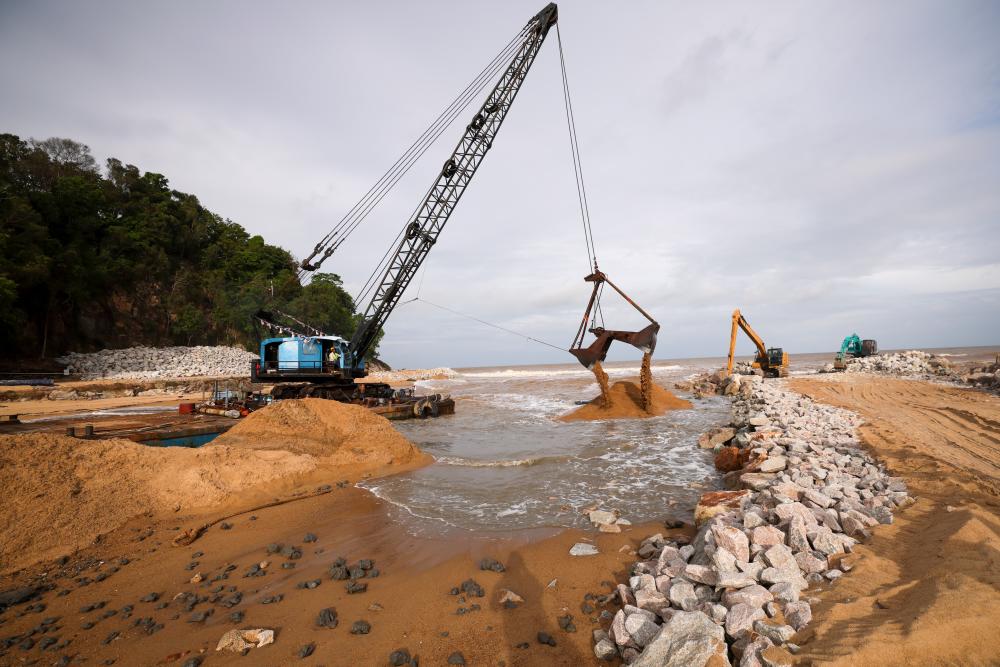PEKAN: The beach erosion control project in Kampung Tanjung Batu, Nenasi, by the Department of Irrigation and Drainage (DID), is scheduled to be completed by March 2026.
Mohd Reezal Mahat, the general manager of Vista Infinity Development Sdn Bhd (Vista) as the project’s main contractor, said that the project, costing RM58 million, which started in March this year, is likely to be completed ahead of schedule, taking into account the progress of the project thus far.
The coastal erosion control work involves the reclamation of a 200-metre-wide area, which stretches 4.3 kilometres (km) from the Sungai Tering estuary heading south, and deepening the estuary to a depth of 1.5 metres (m).
“As of Dec 20, the actual physical work progress at the site has reached 25 per cent, compared with the planned physical progress of 23 per cent. Among the contributing elements is the construction of a 300-metre-long river bank retaining wall, which has reached more than 30 per cent.
“The main function of the wall is to help address shallow Sungai Tering estuary, to ensure that fishermen can use it to go to sea all year around,” he told Bernama, when met at the project site in Kampung Tanjung Batu, here.
Also present were the state Public Works, Transport and Health Committee chairman Datuk Mohammad Fakhruddin Mohd Ariff; Pekan district officer Datuk Zaliza Zulkipli and Vista Group chairman Mohd Ghani Hitam.
Mohd Reezal said that the project also involved the installation of beacon lights, from Spain, to facilitate navigation in and out of the Sungai Tering estuary at night.
In addition, the company is also about to increase the capacity of the marine works fleet, which is water dredging machinery, imported from China, to speed up the sand reclamation work.
“A total of 140,000 metric tonnes of stones will be used for the construction of two estuary training (protective) wall units, involving core stones as the bottom layer and armour stones for the outer layer facing the sea, each of which weighs between one and eight tonnes, obtained from four quarries around Kuantan and Rompin.
“The affected 4.3km beach area will be filled up with sand at least as much as 1.2 million cubic metres, at a distance of 200m wide from the existing beach line.
“This allows the restored beach to be wide, with a gently sloping profile, when completed,” he said, adding that all stones used and embankments must comply with quality standards and specifications, apart from having to go through several engineering tests, which are strictly regulated by consultants and site representatives.
Meanwhile, Mohd Ghani said that the project, when completed, can restore a sense of security and facilitate the movement of residents, as the navigation channel and river estuary will no longer be blocked due to the tides, and fishermen will be free to use the estuary at all times.
“The 200m wide and gently sloping beach will allow this area to be developed as a tourist location, as this area used to have famous chalets before erosion occurred,” he said.
He also said that the project will also indirectly open up job opportunities for locals employed by Vista, in addition to local companies from the transport sector, quarries, hardware stores and restaurants in the surrounding area, gaining business opportunities.
“We have also established a task force team, which is ready 24 hours a day for emergency work throughout the monsoon season. This team, for example, has helped build a temporary barrier of sandbanks, to prevent stormy waves from directly hitting the houses of residents near the beach, so that there are no untoward incidents,” he said.
Meanwhile, Mukim Kampung Tanjung Batu penghulu, Mudzafar Abu Samah, said that the erosion was understood to have started six years ago, but it worsened in 2020, as the shoreline gradually receded towards the houses, at only 20m to 40m.
The erosion also caused the famous resort, Kekunang Tering Chalet, which is located about 100m from the beach, to stop operations due to severe erosion, until it was ‘swallowed’ by the sea.
“It also caused difficulties for nearly 30 fishermen to go out and enter the jetty as the water was getting shallower.
“There were times when fishermen could go out in the morning, but have to push the boat on the way back, and we hope this problem can be resolved because it severely affects their source of income,” he said. - Bernama









